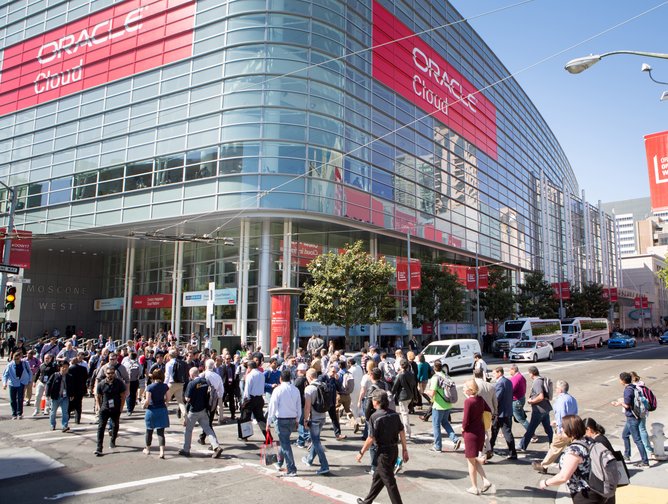Oracle Canada's solution to supply chain transformation in the cloud
When it comes to business computer technology, Oracle is ubiquitous. And when it comes to business applications, Oracle has a similarly strong presence with enterprise-class products and platforms it has developed in-house, integrated with best of breed solutions it has acquired over the years. In areas such as supply chain planning, PLM, logistics, transportation, warehouse, and global trade management it has established itself as a provider of best-in-class, regardless of the backend ERP. Over the last several years the company has been on a journey to redevelop all of these capabilities for the Cloud – starting with CX, then HCM and ERP, and more recently SCM.
Based in Canada, Dan Bloch is Oracle's VP responsible for customers' financial and supply chain needs, predominantly in Eastern Canada and the North Eastern USA, and across multiple industries. For him the cloud is not just the biggest opportunity facing Oracle, but a catalyst for change for almost every aspect of business and consumer life. “We are finding increasingly that with the accelerating speed of change, and emergence of disruptive technologies such as IoT, companies need a platform that can rapidly adopt new capabilities without having to undergo periodic, massive transformations. That platform is the cloud”
In the case of IoT, the terabytes of data that now floods in from a myriad of IP enabled devices, RFID, GPS and other sources must be collected, consolidated and thoroughly analysed. Bloch adds: “This data has the potential to help a supply chain assess what it can do because we get better insight into where materials are prior to manufacturing, for example, and where my post manufacturing products are relative to reaching their endpoint.”
The challenge lies in making all that data usable, he says, and many companies still have some way to go. Gaining insight from that information, and translating that into positive business outcomes is where Oracle differentiates itself. “We have identified the different industries and sub-verticals and are bringing out specific capabilities designed for each. This will always be a continuous journey, but the horizontal infrastructure that enables this is ready now.” For customers this is crucial. For example, a device on a forklift can detect that a piston is overheating, but without sophisticated predictive analytics that signal is meaningless. And without the ability to translate that into action, such as creating a work order, complete with the right tools, material and best-timed dispatch, that signal by itself is just not useful. “Oracle is transforming that signal into real, actionable information and then integrating that into the right ERP and SCM processes,” Bloch says. “That's what is unique.”
The power of 5G, IoT and AI
Communication infrastructure operators justified the capital cost of building out the 4G network on the demand for video streaming. Now they are looking to IoT: the proliferation of devices will require mobile networks that can handle an exponential growth in data. That’s what going to drive the investment in new 5G networks and their 100x speed and capacity. In Canada he sees these forces converging: “Business needs the information these devices can provide, and the ability for those devices to communicate over mobile networks, and to be able to service that information in a way that's relevant to business goals.”
Delivering these services in a cloud environment for supply chain is still relatively new. Oracle has been immensely successful with its traditional on-premise software. Major Canadian businesses are among the many that rely on Oracle supply chain solutions to produce and deliver products to their customers. The territory he looks after is geographically dispersed. Industries like mining and resources operate in remote locations, and for companies like one of the world's largest gold producers, 5G connectivity will be crucial. “We have some great customers,” says Bloch. “They certainly understood where we are headed in terms of enabling IoT information into business practice. We have large commitments to one another to further that agenda.”
Customer-led prioritisation
The communications service providers (CSPs) themselves stand to benefit. They deal with huge amounts of diverse equipment, from their towers and signal boosting equipment to cable boxes, handsets and modems – even the devices that give cars mobile connectivity and their data centres. “As soon as you start dealing with equipment, even if you're not manufacturing that equipment yourself, you create an entire supply chain situation,” Bloch says. “In the old days, if there's a failure somewhere, you would learn about it from a customer, then locate and fix it. Today the fault can be detected automatically. The next step is to not just see a problem, but to predict it, locate it, and resolve it automatically without disruption. The preventative capacity that it creates is amazing and all of this is enabled through the seamless integration of IoT, analytics and SCM.”
The information might be embedded into existing work processes to enable action – or it can be made useful by applying artificial intelligence (AI) with no human intervention. Bloch says: “It's the added insights that AI can provide in real-time that really makes the whole thing exciting, and that is why you are starting to see the lightbulb go off for leaders of supply chain. They see tremendous opportunities to take out cost, to improve service and to decrease cycle times. Budgets stay static at best, so their approaches have to be smarter and more cost effective. AI will enable many savings. I can react to a problem earlier with a less serious maintenance task and not wait until it is more disruptive, costly or even catastrophic. I can reroute my production capacity based on a better understanding of the whereabouts of the problem, or dynamically solve my pre-manufacturing inventory issues.”
Oracle is partnering with customers to drive innovation. “The specifics of a solution may differ but the benefits are not company or industry-specific,” Bloch continues. “These are people who see that the IoT investment and the software investment will drive value in their business. That is a vision we at Oracle share.” The majority of companies today have some sort of work order management process, he says. They vary in the extent to which these processes are digitised, but whether they are running their enterprise on an Oracle backbone or another system, Oracle IoT and SCM solutions can be integrated without the need for a costly migration of their existing backbone. Of course, if that backbone were the Oracle Cloud, the capabilities would be part of the platform.
Beneficial partnerships
Oracle has an accreditation process for its implementation partners, with differentiation on the basis of their experience and the breadth, depth and value that they bring outside of just IT implementation. In many cases a joint collaboration makes sense when approaching an SCM transformation in the context of broader corporate goals. Industry-specific know-how is of particular benefit. For example, it has a number of partners that are very active in Canada and North America. “One partner of ours is very experienced in implementing Oracle solutions across industries in Canada, and North America, so they can anticipate issues before they occur,” says Bloch. “For example, in the US there is a new accounting standard called ASC 606 which governs revenue recognition and deferred obligations in customer contracts, similar to the IFRS 15 requirement. Given this particular partner’s expertise in auditing, they can anticipate the needs to collect contract level information during an ERP or supply chain implementation and make the appropriate design considerations up front to satisfy this accounting requirement.”
Again, this is something that differentiates cloud from on-premise solutions, he says. “On-Premise software brings with it a greater burden, in resources and cost, of customisation and upgrading. To that extent its benefits are short term. In contrast, while the Oracle Cloud does permit extensive configuration and even the development of extensions, it does not allow the customer to customise. This is a good thing. While customers typically go through some change management to use the software the way it is designed, this ultimately that puts them in a highly sustainable place and at a much lower cost. It allows them to standardise whatever they can and still to differentiate in the areas they need to – those areas that really create the identity and differentiation of their business. And most importantly, it allows then to continuously receive new capabilities and innovations without the need for complex and costly upgrades.
“I am so excited about the wealth and the breadth of the capabilities we are bringing to market and the potential impact we can have on the Canadian market. That we have Canadian data centres to provide these services will allay any concerns around data appropriation. We can service customers of every size and complexity. And we can help customers standardise and differentiate what makes their companies and products unique. I never want to suggest that we have all the answers. We are always in partnership with our customers, who are our best teachers. We love their feedback.”






